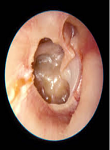|
|
|
EDITORIAL : Combination of Two Ancient Technologies to Improve Diagnosis of Otitis Media
|
|
|
|
|
|
|
|
|
|

|
|
|
Ashley M. Fenn, Ph.D.
|
|
|
|
Harvard Medical School
|
Center for Systems Biology, MGH-HMS, Boston, MA 02114, USA
|
|
afenn@mgh.harvard.edu
|
|
|
|
|
|
|
|
|
|

|
|
A mom rushes into the pediatrician’s office with her screaming two-year old girl, Becca. Becca has been irritable for several days and has not been eating, but now she also has a fever and is crying incessantly. The pediatrician evaluates Becca’s middle ear with an otoscope, knowing that an ear infection (i.e., otitis media), is the most common childhood illness (Cripps et al., 2005). The otoscope has been used for centuries with the first depiction illustrated in 1364. Since then the otoscope has undergone many advances to improve its function and ease of use, but has remained relatively unchanged since the development of the pneumatic otoscope in 1864. This 1864-based model is what the pediatricians use currently.
|
|
|
|
|
|
|
|

|
|